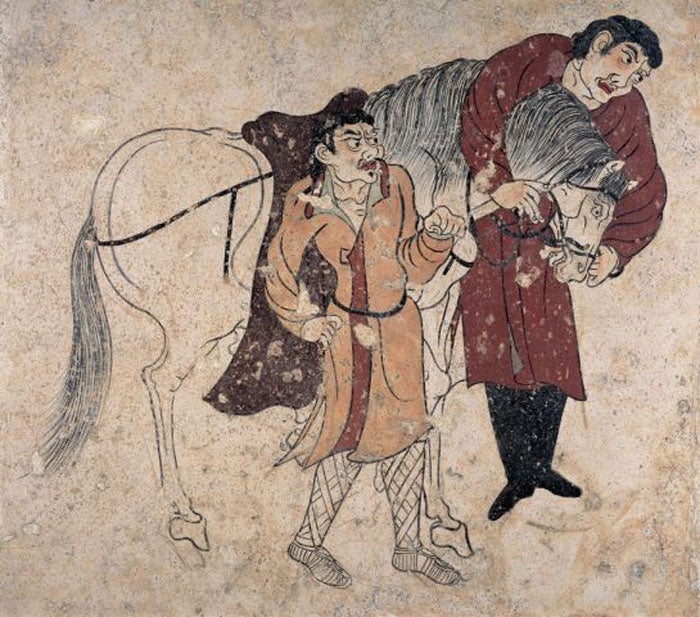China: At The Court Of The Emperors<br />China China China!!! Chinese Contemporary Art, Palazzo Strozzi, Florence

What is Florence for? Anyone who stands in the Piazza della Signoria and stares at the self-vaunting bronze equestrian statue of Cosimo de Medici will know the answer to that question. Florence exists to proclaim the greatness of Florence, to be the near-perfect embodiment of its own tremendous civic pride. This is one of the reasons why Florence is not much of a centre for art from elsewhere.
Why take the trouble when all Florence needs to do is, like the Ancient Mariner, to take the visitor aside and proclaim, ad nauseam, the stories of its achievements as the place where many of the greatest artists and writers of the Renaissance (and the pre-Renaissance) left some of their most enduring legacies – and often got punished for their pains? The statues of many of them line the outside of the Uffizi to this day.
But is that quite enough in these days of mass tourism and cultural overload? The Palazzo Strozzi, a foundation situated within one of those ferociously embattled-looking, 16th-century palazzi just five minutes' walk from Brunelleschi's great cathedral dome, believes not. If Florence is to continue to survive as a city, it needs to stare beyond its own crenellated parapets, and engage in a debate with the cultures of the rest of the world. That way it will continue to survive into the future.
This is why the Strozzi is currently playing host to not one but two shows of Chinese art, one in its magnificently appointed state-rooms at first-floor level, devoted to a survey of masterpieces from the Han and Tang dynasties, and the other, in a more awkward, crypt-like space underground, to contemporary Chinese art from three urban centres, Beijing, Shanghai and Canton. The second show is curated by three separate individuals. Two of them are Chinese, and a third has spent a large part of his life working in China.
The two shows make for strange bedfellows. One of the shows – the older one – is brilliant; the other is only partially successful. The Han/Tang show is important because it brings to Europe for the first time many masterpieces from a period that is universally regarded as the golden age of China's plastic and literary arts. This show also makes the difficult art of exhibition-making look relatively easy. It sweeps us, room by room, through a selection of well selected themes that are well summarised by their wall texts, and then it illustrates those themes by means of judiciously chosen objects.
The show is large, but no single space ever feels over-loaded. The intellectual content is substantial, but the explanatory material never makes us reel with bewilderment, as did the wall-texts that accompanied the Turks show at the Royal Academy three years ago. In short, there are many riches here, but they are laid out sparingly and judiciously. Some of the finest pieces here are ceramic, in rooms devoted to caricatures of foreign visitors, an exploration of the roles of women, and the importance of horses in Chinese society.
Downstairs, life gets more complicated. For a start, the space itself is quite difficult to negotiate. The low-ceilinged galleries are of different shapes and sizes. Nothing seems to quite occupy its given ground with much ease or sense of inevitability. Where does the Canton sector end exactly and Beijing begin? Some rooms are part-divided from each other by what look a little like near perfectly fashioned wedges of Parmesan cheese. Why, in heaven's name?
The Canton sector is the most underwhelming. Many of the pieces are video works, but some of them don't really seem to have earnt their right to exist. A mother cuddles her child. Other children have white cream flung into their faces. Another film shows a sleeping cat. What's the point of all this? Why are we being encouraged to believe that this is worth paying attention to for more than a few seconds?
What is certainly worth paying attention to is An Estranged Paradise, shot in monochrome, by Yang Fudong, which charts, spasmodically, the story of a young couple's life in the port city of Hangzhou. It has a kind of gentle Proust-cum-nouvelle-vague flavour. Generally speaking, we are able to sense in some of these rooms the excitement of young artists wrestling with new technologies for the first time, inching towards new worlds of artistic possibility, but not quite reaching their destinations, not yet.
China at the Court of the Emperors to 8 June; China! China! China! to 4 May (00 39 055 246 9600; www.palazzostrozzi.org)
Subscribe to Independent Premium to bookmark this article
Want to bookmark your favourite articles and stories to read or reference later? Start your Independent Premium subscription today.

Join our commenting forum
Join thought-provoking conversations, follow other Independent readers and see their replies